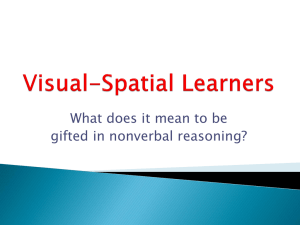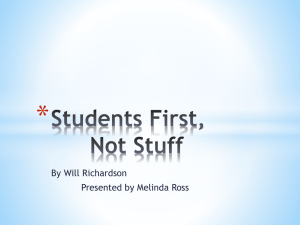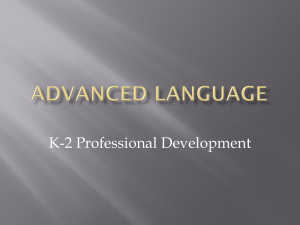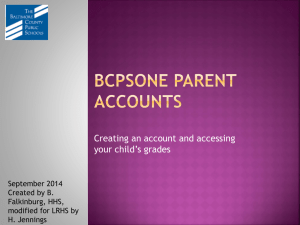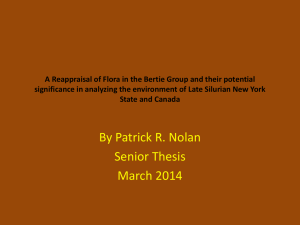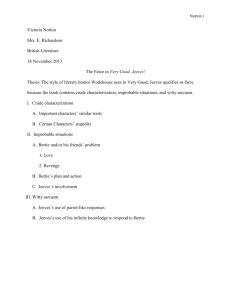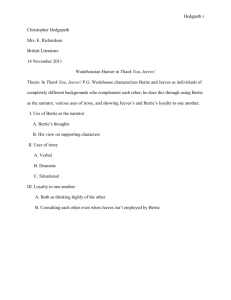Differentiation Strategies - Wiki
advertisement
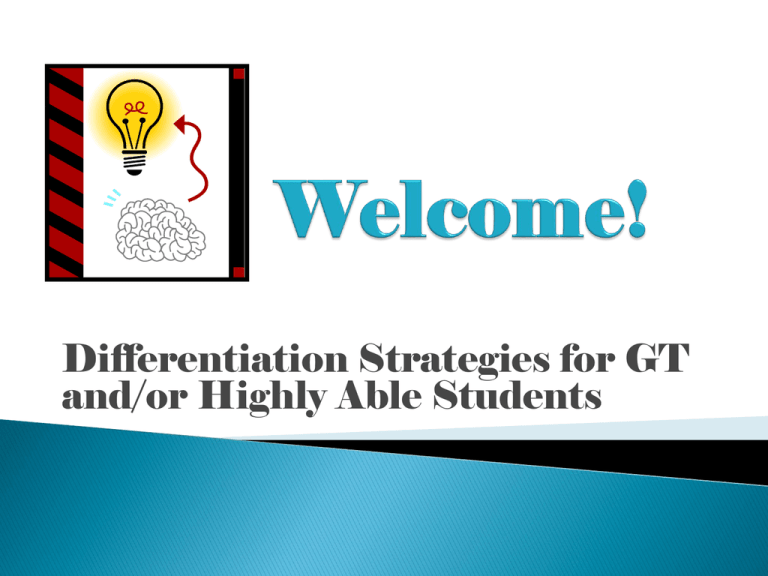
Differentiation Strategies for GT and/or Highly Able Students Make a tent out of a sheet of card stock paper. On one side of your “tent” write your name large enough for others to see. Divide the other side of your “tent” into four quadrants. 1. 2. 3. 4. In the upper left quadrant, write the name of your school. In the upper right quadrant, write the grades and courses you teach. In the lower left quadrant, draw a picture/symbol that shows something about you. In the lower right quadrant, draw or write about your plans for the summer. Activity: Brainwriting Chapter Four : pages 100-102 Reaching All Learners ~Bertie Kingore A written variation of brainstorming increases mental engagement for all students. Results invite students to compare and contrast concepts related to a topic. Products are a rich resource for summarization or expanded writing about a topic. ACADEMIC STEREOTYPES STRENGTHS ADVANCED LEARNERS ACADEMIC NEEDS SOCIAL/EMOTIONAL We all know what you what key elements we should be differentiating: 1. Content 2. Process 3. Product 4. Environment 5. Assessment Why differentiate instruction with a group of students, whether GT or standard? The simple answer, we all know, comes from some well known gifted education researchers--- Carol Tomlinson, Joyce Van Tassel-Baska, Donna Ford, Susan Winebrenner, Nicholas Colangelo and Gary Davis, Paul Slocumb, and Ruby Payne, and, of course, Bertie Kingore, and others…. They emphasize that all students are different, and therefore, require different instruction in order to teach/engage them. (Differences can be ethnic, racial, cultural, socio-economic.) Joyce Van Tassel-Baska, Ed. D. from the Center for Gifted Education at the College of William and Mary, Virginia: http://www.openc.k12.or.us/reaching/tag/context.html (2 min. audio on “Experience”) Differentiated classrooms offer learning options that tap into readiness levels, interests, and learning profiles. You will see: 1. A variety of ways for students to explore content 2. A variety of activities/processes enabling students to understand and “own information and ideas” 3. A variety of options through which students can demonstrate/exhibit mastery Wordle gives us the answer: http://www.wordle.net/ Pace and variety in instruction are especially important for the advanced learner. Potential issues DI addresses for the advanced learner: 1. May become bored 2. Can become mentally lazy, even though they do well in school 3. May think grades are more important than ideas 4. May become perfectionists 5. May fail to develop a sense of self-efficacy 6. May fail to develop study and coping skills “Integrating elements of abstract thinking, complexity, and depth (ACD) avoids instruction based on advanced and gifted students doing more, working harder, or making less errors; the focus instead is on students thinking differently.” --Bertie Kingore, Ed. D. "When gifted students exceed standards at given stages of development, accelerate them to the next level within or across subjects, within or across levels.“ --Joyce VanTassel-Baska, Ed. D. Bertie Kingore---to provide ACD: “Teachers concluded that when they prompt more abstract thinking, complexity, and depth they are more likely to get the advanced thinking they expected. Gifted learners need opportunities for abstract thinking and complex content to stay mentally engaged in learning...” See Kingore handout on ACD related to thinking and inquiry (discussion): Abstractions, Change over time, Essential questions, Ethics, Generalizations, Interdisciplinary content, Issues, Language and terminology, Methodology, Patterns, Perspectives, Resources and technology Coming up….We’ll look at moving the advanced learner to “other activities.” Turn and Talk What concerns do teachers sometimes have with using small group instruction in their classroom? Set rules together. Create a contract to be signed by both the student and a parent. Start small! Use grouping strategies frequently so that students remain “trained”. Examine the “Small Group Implementation Schedule” “Getting Started” suggestions on pages 63-66. “Learning Behaviors Rubric” on page 56. Reaching All Learners ~Bertie Kingore Whole Class Similar-Ability Small Groups Mixed-Ability Small Groups Individual Work What are the advantages and disadvantages of each type of grouping? On your blank sheet of paper, write down your response to one of the following questions: What is one idea for grouping that will try to implement next school year? Why does this idea appeal to you? What is one suggestion that you have for a teacher new to grouping based on your prior experience? Earlier, we looked at “why to differentiate” for the advanced learner. We reviewed the need to provide “pace and variety” and ACD. But, how to differentiate for these learners? We start with at least two basic pre-instruction activities: 1. Content pre-assessments---whether formal or informal 2. Student Interest Survey/Inventory---learn about talents, passions 2a. BCPS “Learning Preference Survey” 3. This info/data will lead us to “SEEA” or compacting the content Once we determine what the student(s) mastery, then we can move to differentiating the content by: S = Substituting E = Extending E = Enriching A = Accelerating Possibilities for substituting lesson(s): 1, When the class has already read a particular work, is it possible to substitute a different work by the same author or a work from the same genre? 2. Can you substitute an author of the same time period, style, etc.? Possibilities for extending content: 1. Journaling on a book or author under study 2. Journaling on literary elements 3. Animoto book review 4. Soapstone another book by the same author under study 5. Service Learning projects Possibilities for enriching lesson(s): 1. Based on student Interest Survey, student selects a project from the Product List or Choice Box or Options List that they want to do. Example: Research/produce a video on a contemporary African American writer 2. Website/wiki exploring the Great Depression and the current recession 3. A Student Service Learning project related to a contemporary issue of interest to the student Possibilities for accelerating lesson--(earlier and faster paced): 1. Students read books at the next grade level and select their own product/ assessment of the books 2. Students read several of one author’s books, rather than one, then select their own product/assessment Review Product Options on pages 26-27 in Kingore’s Reaching All Learners and list one product that you could use for each --Substituting Extending Enriching Accelerating Your SEEAs: Chapter Four : pages 85-170 Reaching All Learners ~Bertie Kingore age Number Strategy 88 Assessment and Evaluation Card A&E 92 Analogies 100 Brainwriting 115 Four Corners 145 Riddles 148 SCAMPER 152 Summarization Page Number Strategy 155 T-Time 164 Top Ten 166 Topic Talk Topic Talk and Switch Other Other Other Other Notes on Process Ideas for how you might implement this strategy with advanced learners Notes on Process Ideas for how you might implement this strategy with advanced learners Promotes the review and organization of information Serves as a springboard for summarization, topic discussions, and vocabulary development Encourages students’ high-level thinking Assesses students’ accuracy, depth, and complexity of content Teaching Without Nonsense~Bertie Kingore A technique for succinctly retelling and organizing information May be completed in words, phrases, or complete sentences which may elicit higher thinking Teaching Without Nonsense~Bertie Kingore Using the word DIFFERENTIATION on the first line designated as “subject”, use the Thinking Triangle to represent your thoughts and point of view about the strategies you have learned and discussed during this workshop. There are two main reasons for providing technology integration with advanced learners: 1. Allow them virtual experiences in their area of interest, passion, gift, or talent that they cannot experience otherwise. 2. Allow them to practice with and create products that go beyond the “pencil and paper” products/assessments/depths provided in traditional instruction. Web 2.0 tools and Digital Blooms’ Taxonomy is provided by BCPS and Promotes the use of higher order thinking skills and Internet tools. http://www.bcps.org/offices/lis/Reference/reference.html#Blooms "For gifted children, there will be information available on almost any interest they have -- anything from sites such as NASA for those interested in Astronomy to sites on literature, geology, history, and Star Trek. Also many of these sites offer more than one-way information. Most WWW authors cheerfully respond to email queries from their pages and will provide specific information requested. Next time you or your child has one of those questions which you can't find an answer, someone on the Internet probably can and will if you ask them." The Internet and Gifted and Talented Children by Gayle Dallaston Web 2.0 tools and Digital Blooms’ Taxonomy: http://www.bcps.org/offices/lis/Reference/reference.html#Blooms Free technology for teachers: http://www.freetech4teachers.com/p/free-downloads.html BCCP Web 2.0 wiki: http://bcpslibraryinformationservices.pbworks.com/w/page/12773114/FrontPage Complete the alphabet grid with ideas or thoughts that you will take away from this workshop.





